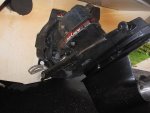UncleSpidey
Seaman
- Joined
- Sep 12, 2011
- Messages
- 50
Okay...so I've been looking at a 1989 Chaparral Villain III. The survey and sea trial was earlier this week. The only area of major concern to me is a high reading on the moisture meter in two places on the upper transom where the rail for the swim platform attaches. There are some hairline cracks in the gelcoat where the rail attaches, and you can see a small amount of rust at these points. After the sea trial I can clearly see what happens. When the boat is slowed from cruise, water will wash up onto the swim platform. Clearly, the attachment points for the rail are not adequately sealed, and there has been some seepage of moisture into the upper transom. It maps out pretty clearly, and doesn't appear to extend below the level of the swim platform. Everything else measured dry (although he couldn't really get to the stringers very well). By percussion, there doesn't seem to be delam of the wood.
Pictures may help explain. The green tape defines the areas of high moisture. Outside the taped area measures dry.


The text of the report is as follows:
*Transom: The transom above the dive platform exhibited high moisture levels measured by a GRP-33 meter but no
indications of delamination when percussion tested. The affected areas were around the standoffs on the dive platform
rail that showed indications of rust and water intrusion. While the rail appears solid at this time, this condition can be
expected to be progressive and will lead in time to weakening of the entire transom unless efforts are made to properly
seal the leaking areas and arrest the spread of moisture.
Sounding and Moisture Readings: Except as noted on the transom, all readings were in acceptable range.
Now ideally, a core test should be done, but that isn't going to happen unless I buy the boat at which point the question of whether to walk away is kinda' moot.
So what do you think? Should I look at this as the early stages of a cancer that is ultimately going to require the replacement of the transom? Since the area still feels solid with the hammer, can I just seal this up to prevent further intrusion of water and keep an eye on it? If I do seal it up, am I just trapping the existing moisture in there to continue to wick through the entire transom? Is this an area where something like CPES might work? Is the world just too full of good used boats to waste your time on one that needs a little love??
Buying a boat is just simply NOT a rational decision!!
Spidey
Pictures may help explain. The green tape defines the areas of high moisture. Outside the taped area measures dry.


The text of the report is as follows:
*Transom: The transom above the dive platform exhibited high moisture levels measured by a GRP-33 meter but no
indications of delamination when percussion tested. The affected areas were around the standoffs on the dive platform
rail that showed indications of rust and water intrusion. While the rail appears solid at this time, this condition can be
expected to be progressive and will lead in time to weakening of the entire transom unless efforts are made to properly
seal the leaking areas and arrest the spread of moisture.
Sounding and Moisture Readings: Except as noted on the transom, all readings were in acceptable range.
Now ideally, a core test should be done, but that isn't going to happen unless I buy the boat at which point the question of whether to walk away is kinda' moot.
So what do you think? Should I look at this as the early stages of a cancer that is ultimately going to require the replacement of the transom? Since the area still feels solid with the hammer, can I just seal this up to prevent further intrusion of water and keep an eye on it? If I do seal it up, am I just trapping the existing moisture in there to continue to wick through the entire transom? Is this an area where something like CPES might work? Is the world just too full of good used boats to waste your time on one that needs a little love??
Buying a boat is just simply NOT a rational decision!!
Spidey






















